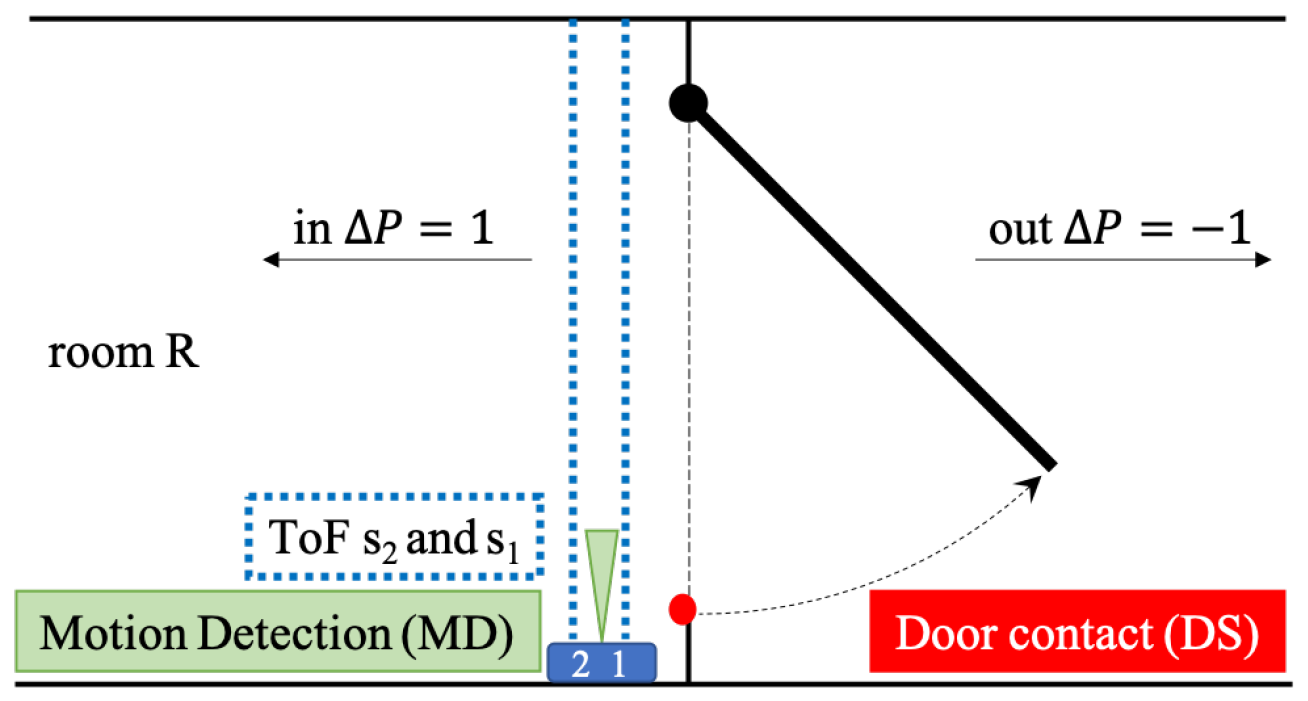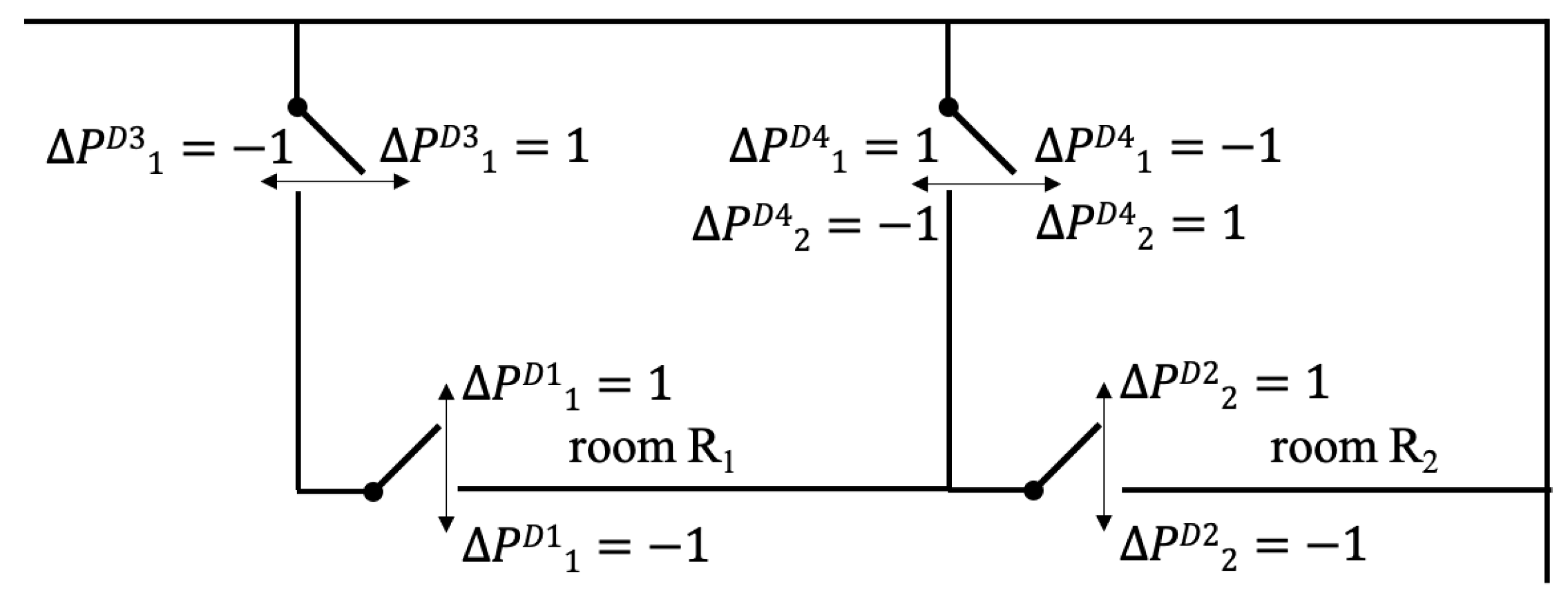Development of a Sensor to Measure Physician Consultation Times
Abstract
:1. Introduction
- (a)
- Self-reported means that a member of the healthcare staff (mostly the treating physician) answered a survey or provided a collection of duration times. These self-reported figures can, however, be categorised as biased.
- (b)
- Video means that a video recording of the activities in the treatment room were evaluated. This approach needs the patient’s recruitment and consent and is highly problematic regarding the General Data Protection Regulation (GDPR).
- (c)
- Audio recordings are used to verify the duration of patient–physician interactions; however, similarly to the video method, audio recordings are problematic regarding GDPR.
- (d)
- As part of the stopwatch method, a member of the healthcare staff (mostly the treating physician) timed the consultation period. This method is more reliable, as the net results can be evaluated. However, a comparison to gross results is not possible.
- (e)
- A short message (SMS) is sent by a member of the healthcare staff or the physician to a certain phone number, deriving the consultation duration time from the received message.
- (f)
- World Health Organisation/International Network for the Rational Use of Drugs (WHO/INRUD) means using data provided by the drug use indicators for health facilities, which contain a set of patient care indicators including the average consultation time. The number is evaluated by “dividing the total time for a series of consultations by the number of consultations”.
- (g)
- Calculation means that certain time parameters were collected and average consultation duration times were derived. Most of the data sets used to do the calculations cannot be verified.
2. Materials and Methods
2.1. Overview and Objectives
2.2. Combination of the Sensors
2.3. Prototype Development
3. Results
3.1. Single Door
3.2. Multi Door and Room Set-Up
4. Discussion
5. Conclusions
Notation
| d | distance sensor to opposing wall (mm) |
| index numbering of detected events at the door (-) | |
| index numbering the loops (-) | |
| measured value of the ToF sensor (mm) | |
| difference (mm) | |
| t | time (sec) |
| time step (sec) | |
| change (Person) | |
| R | persons in the room (Person) |
| D | door |
| DS | door sensor |
| GDPR | General Data Protection Regulation |
| INRUD | International Network for the Rational Use of Drugs |
| MD | motion detector |
| PIR | passive infrared sensor |
| ToF | Time of Flight |
| WHO | World Health Organisation |
Author Contributions
Funding
Conflicts of Interest
References
- Government—Office of Science: Future of an Ageing Population 2016. Available online: https://assets.publishing.service.gov.uk/government/uploads/system/uploads/attachment_data/file/ 816458/future-of-an-ageing-population.pdf (accessed on 24 October 2019).
- Irving, G.; Neves, A.L.; Dambha-Miller, H.; Oishi, A.; Tagashira, H.; Verho, A.; Holden, J. International variations in primary care physician consultation time: A systematic review of 67 countries. BMJ Open 2017, 7, e017902. [Google Scholar] [CrossRef]
- Al-Zaydi, Z.Q.H.; Ndzi, D.L.; Kamarudin, M.L.; Zakaria, A.; Shakaff, A.Y.M. A robust multimedia surveillance system for people. Multimed. Tools Appl. 2017, 76, 23777–23804. [Google Scholar] [CrossRef]
- Wang, W.; Liu, P.; Ying, R.; Wang, J.; Qian, J.; Jia, J.; Gao, J. A High-Computational Efficiency Human Detection and Flow Estimation Method Based on TOF Measurements. Sensors 2019, 19, 729. [Google Scholar] [CrossRef] [Green Version]
- Xia, T.; Fan, H.; Yu, S.; Zhang, L.; Wen, J. An improved multi-target tracking algorithm for pedestrian counting. J. Phys. Conf. Ser. 2018, 1069, 012113. [Google Scholar] [CrossRef]
- Lee, G.-C.; Lee, S.-H.; Yoo, J. 3-D People Counting with a Stereo Camera on GPU Embedded Board. Appl. Sci. 2018, 8, 2017. [Google Scholar] [CrossRef] [Green Version]
- Li, J.; Zhang, F.; Wei, L.; Yang, T.; Lu, Z. Nighttime Foreground Pedestrian Detection Based on Three-Dimensional Voxel Surface Model. Sensors 2017, 17, 2354. [Google Scholar] [CrossRef] [Green Version]
- Mousavi, E.S.; Jafarifiroozabadi, R.; Bayramzadeh, S.; Joseph, A.; San, D. An observational study of door motion in operating rooms. Build. Environ. 2018, 144, 502–507. [Google Scholar] [CrossRef]
- CQR Surface Contacts. Available online: https://cqr.co.uk/contacts/surface-contact/ (accessed on 1 October 2019).
- GitHub jdesbonnet/RCWL-0516. Available online: https://github.com/jdesbonnet/RCWL-0516/ (accessed on 1 October 2019).
- Huang, Q.; Rodriguez, K.; Whetstone, N.; Habel, S. Rapid Internet of Things (IoT) prototype for accurate people counting towards energy efficient buildings. J. Inf. Technol. Constr. 2019, 24, 1–13. [Google Scholar] [CrossRef] [Green Version]
- Kim, B.H.; Khan, D.; Bohak, C.; Choi, W.; Lee, H.J.; Kim, M.Y. V-RBNN Based Small Drone Detection in Augmented Datasets for 3D LADAR System. Sensors 2018, 18, 3825. [Google Scholar] [CrossRef] [Green Version]
- Beer, M.; Haase, J.F.; Ruskowski, J.; Kokozinski, R. Background Light Rejection in SPAD-Based LiDAR Sensors by Adaptive Photon Coincidence Detection. Sensors 2018, 18, 4338. [Google Scholar] [CrossRef] [Green Version]
- Li, X.; Yang, B.; Xie, X.; Li, D.; Xu, L. Influence of Waveform Characteristics on LiDAR Ranging Accuracy and Precision. Sensors 2018, 18, 1156. [Google Scholar] [CrossRef] [Green Version]
- Suh, Y.S. Laser Sensors for Displacement, Distance and Position. Sensors 2019, 19, 1924. [Google Scholar] [CrossRef] [Green Version]
- Yin, D.; Liu, J.; Wu, T.; Liu, K.; Hyyppä, J.; Chen, R. Extrinsic Calibration of 2D Laser Rangefinders Using an Existing Cuboid-Shaped Corridor as the Reference. Sensors 2018, 18, 4371. [Google Scholar] [CrossRef] [Green Version]
- Carballo, A.; Ohaya, A.; Yuta, S. Reliable People Detection Using Range and Intensity Data from Multiple Layers of Laser Range Finders on a Mobile Robot. Int. J. Soc. Robot. 2011, 3, 167–186. [Google Scholar] [CrossRef]
- Lee, J.H.; Kim, Y.S.; Kim, B.K.; Ohba, K.; Kawata, H.; Ohya, A.; Yuta, S. Security door system using human tracking method with laser range finders. In Proceedings of the 2007 IEEE International Conference on Mechatronics and Automation, Harbin, China, 5–8 August 2007. [Google Scholar]
- Zengeler, N.; Kopinski, T.; Handmann, U. Hand Gesture Recognition in Automotive Human–Machine Interaction Using Depth Cameras. Sensors 2019, 19, 59. [Google Scholar] [CrossRef] [Green Version]
- CPC Technical Datasheet VL53L0X. Available online: http://www.farnell.com/datasheets/2703141.pdf (accessed on 1 October 2019).
- Handscombe, J.; Yu, H.Q. Low-Cost and Data Anonymised City Traffic Flow Data Collection to Support Intelligent Traffic System. Sensors 2019, 19, 347. [Google Scholar] [CrossRef] [Green Version]
- Aguero, M.; Ozdagli, A.; Moreu, F. Measuring Reference-Free Total Displacements of Piles and Columns Using Low-Cost, Battery-Powered, Efficient Wireless Intelligent Sensors (LEWIS2). Sensors 2019, 19, 1549. [Google Scholar] [CrossRef] [Green Version]
- Strigaro, D.; Cannata, M.; Antonovic, M. Boosting a Weather Monitoring System in Low Income Economies Using Open and Non-Conventional Systems: Data Quality Analysis. Sensors 2019, 19, 1185. [Google Scholar] [CrossRef] [Green Version]
- Steffen, T.M.; Hacker, T.A.; Mollinger, L. Age- and gender-related test performance in community-dwelling elderly people: Six-Minute Walk Test, Berg Balance Scale, Timed up & Go Test, and gait speeds. Phys. Ther. 2002, 82, 128–137. [Google Scholar]
- Kretz, T.; Grünebohm, A.; Kessel, A.; Klüpfel, H.; Meyer-König, T.; Schreckenberg, M. Upstairs walking speed distributions on a long stairway. Saf. Sci. 2008, 46, 72–78. [Google Scholar] [CrossRef]
- Lindemann, U.; Schwenk, M.; Klenk, J.; Kessler, M.; Weyrich, M.; Kurz, F.; Becker, C. Problems of older persons using a wheeled walker. Aging Clin. Exp. Res. 2016, 28, 215–220. [Google Scholar] [CrossRef] [PubMed]
- Kesler, R.M.; Klieger, A.E.; Boes, M.K.; Hsiao-Wecksler, E.T.; Klaren, R.E.; Learmonth, Y.; Motl, R.W.; Horn, G.P. Egress Efficacy of Persons with Multiple Sclerosis During Simulated Evacuations. Fire Technol. 2017, 53, 2007–2021. [Google Scholar] [CrossRef] [Green Version]
- Crozara, L.F.; Marques, N.R.; LaRoche, D.P.; Pereira, A.J.; Silva, F.C.C.; Flores, R.C.; Payao, S.L.M. Hip extension power and abduction power asymmetry as independent predictors of walking speed in individuals with unilateral lower-limb amputation. Gait Posture 2019, 70, 383–388. [Google Scholar] [CrossRef]
- Choi, J.W.; Quan, X.; Cho, S.H. Bi-Directional Passing People Counting System Based on IR-UWB Radar Sensors. IEEE Internet Things J. 2018, 5, 512–522. [Google Scholar] [CrossRef]
- Kura, S.; Yamaguchi, H.; Shiraishi, Y. Low-cost pedestrian counter using Wi-Fi APs for smart building applications. Proc. Int. Comput. Softw. Appl. Conf. 2018, 2, 640–645. [Google Scholar]
- Yang, Y.; Cao, J.; Liu, X.; Liu, X. Wi-Count: Passing People Counting with COTS WiFi Devices. In Proceedings of the 2018 27th International Conference on Computer Communication and Networks (ICCCN), Hangzhou, China, 30 July–2 August 2018; pp. 1–9. [Google Scholar]





| ToF | DS | MD | Conclusion Event | |
|---|---|---|---|---|
| mD | o + c | mD | ±1 | incoming or outgoing person |
| mD | O | mD | ±1 | incoming or outgoing person (open door) |
| mD | o + c | nD | ±1 | incoming or outgoing person (MD error) |
| mD | O | nD | ±1 | incoming or outgoing person (MD error) |
| mD | C | mD | 0 | passing by inside * or error |
| nD | O or C | mD | 0 | passing by outside * or error |
| nD | c | mD | 0 | door closed only (typical for automatic door closer) |
| nD | o | mD | 0 | door is opend but nobody comes in |
| nD | o + c | nD | 0 | error DS |
© 2019 by the authors. Licensee MDPI, Basel, Switzerland. This article is an open access article distributed under the terms and conditions of the Creative Commons Attribution (CC BY) license (http://creativecommons.org/licenses/by/4.0/).
Share and Cite
Gabl, R.; Stummer, F. Development of a Sensor to Measure Physician Consultation Times. Sensors 2019, 19, 5359. https://doi.org/10.3390/s19245359
Gabl R, Stummer F. Development of a Sensor to Measure Physician Consultation Times. Sensors. 2019; 19(24):5359. https://doi.org/10.3390/s19245359
Chicago/Turabian StyleGabl, Roman, and Florian Stummer. 2019. "Development of a Sensor to Measure Physician Consultation Times" Sensors 19, no. 24: 5359. https://doi.org/10.3390/s19245359






